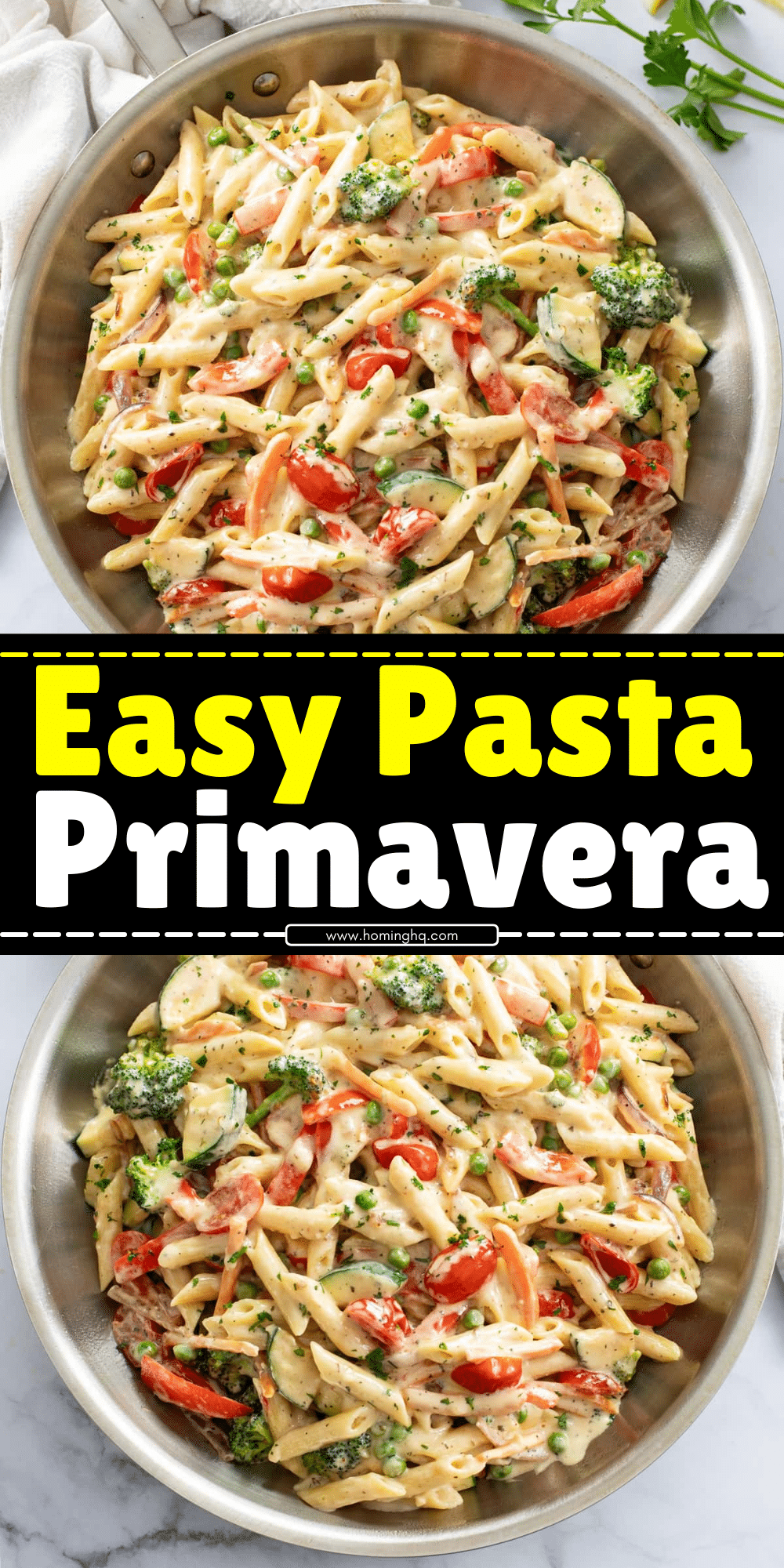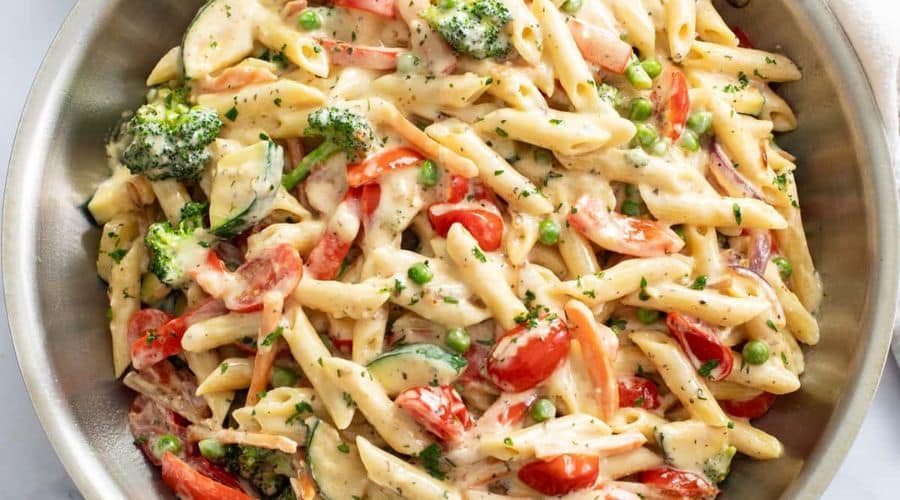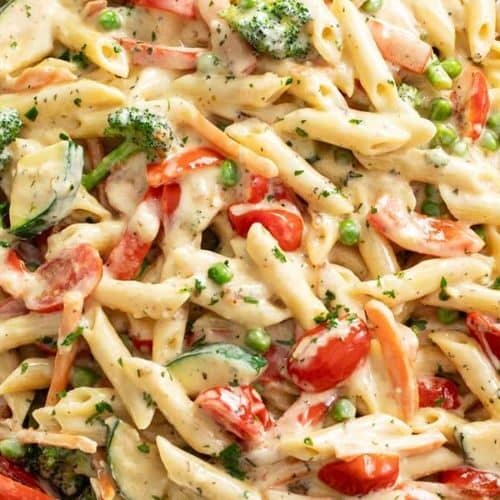All products are selected by our editorial team for quality. If you buy through our links, we may earn a small commission at no extra cost to you.
Pasta Primavera is a vibrant, fresh, and flavorful dish that showcases the beauty of seasonal vegetables tossed with pasta in a light, aromatic sauce.
Originating in the 1970s, this dish quickly became a favorite among home cooks and chefs alike due to its versatility and healthy appeal.
The word “Primavera” translates to “spring” in Italian, which is fitting since the dish is often made with the freshest produce of the season.
However, thanks to its adaptability, Pasta Primavera can be enjoyed year-round, offering a delicious way to incorporate more vegetables into your meals.
This simple yet satisfying dish has become a beloved staple for its balance of textures and flavors—crispy, sautéed vegetables paired with tender pasta, finished with fresh herbs, Parmesan cheese, and a zesty drizzle of olive oil.
Whether you’re making it as a light lunch, a quick weeknight dinner, or a stunning side dish for a gathering, Pasta Primavera is sure to impress with its beauty and taste.

Ingredients: The Fresh Flavors of Pasta Primavera
To make a perfect Pasta Primavera, fresh, high-quality ingredients are key to bringing out the dish’s natural flavors.
While the recipe allows for customization based on your preferences or what’s in season, there are a few essential ingredients that form the heart of the dish.
Pasta
The foundation of any Pasta Primavera is, of course, the pasta.
While traditional recipes often use spaghetti or fettuccine, feel free to experiment with your favorite type of pasta.
Penne, farfalle, or linguine work just as well. Opt for a hearty whole-grain pasta or gluten-free variety if desired, depending on dietary needs.
Vegetables
The true star of Pasta Primavera is the medley of fresh, colorful vegetables. These can include:
- Zucchini: Lightly sautéed for a tender yet slightly crunchy texture.
- Bell Peppers: Sweet and crisp, adding a burst of color and flavor.
- Cherry Tomatoes: Sweet, juicy bursts of flavor when roasted or sautéed.
- Peas: Fresh or frozen, they add a pop of sweetness to balance the other flavors.
- Carrots: Thinly sliced or julienned for an added crunch and vibrant color.
Feel free to adapt the vegetable selection based on what’s in season or what you have on hand. Broccoli, asparagus, and spinach are great additions too.
Herbs and Seasonings
The right combination of fresh herbs and seasonings will elevate the flavors of your Pasta Primavera:
- Garlic: Adds aromatic warmth and depth when sautéed.
- Basil and Parsley: Fresh herbs provide a bright, herbaceous note that balances the richness of the olive oil.
- Lemon Zest: A subtle hint of citrus brightens the dish, giving it a fresh and tangy finish.
- Salt and Pepper: Essential for seasoning, allowing the vegetables and pasta to shine.
Cheese
A generous grating of Parmesan or Pecorino Romano adds a savory, umami-rich flavor that complements the freshness of the vegetables.
If you’re looking for a vegan option, nutritional yeast or dairy-free cheese alternatives can be used for a similar cheesy finish.
Olive Oil
Use good-quality extra virgin olive oil for sautéing the vegetables and creating a light, flavorful sauce that coats the pasta perfectly.
Extras
While the traditional Pasta Primavera is a veggie-focused dish, you can customize it by adding a source of protein such as grilled chicken, shrimp, or even tofu.
This turns the dish into a more filling meal, perfect for lunch or dinner.
Step-by-Step Instructions for Making Pasta Primavera

Making Pasta Primavera is a straightforward process, and with a few simple steps, you can create a vibrant, satisfying dish that highlights the freshness of seasonal vegetables.
Follow these instructions for a perfect balance of tender pasta, sautéed vegetables, and bright flavors.
Step 1: Preparing the Pasta
Start by bringing a large pot of salted water to a boil. The salt is essential for seasoning the pasta while it cooks.
Add your chosen pasta to the boiling water and cook according to the package instructions, typically 8-10 minutes for most varieties.
For the best results, aim for al dente pasta, which should still have a slight firmness when bitten.
Once the pasta is cooked, reserve about 1 cup of pasta water and drain the rest.
Set the pasta aside, and don’t forget to keep that extra water—it will help create a silky sauce when combined with the vegetables later.
Step 2: Sautéing the Vegetables
While the pasta is cooking, it’s time to prepare the vegetables. Heat a large skillet or sauté pan over medium heat and add 2 tablespoons of olive oil.
Once the oil is hot, add garlic and sauté for 1-2 minutes, or until fragrant. Be careful not to burn the garlic.
Add the vegetables in stages, starting with the ones that take longer to cook. Begin with the carrots and zucchini, and sauté for 3-4 minutes, or until they begin to soften. Next, toss in the bell peppers and cherry tomatoes, cooking for an additional 3-4 minutes. Finally, add the peas and sauté for another 2 minutes, just enough to warm them through.
You want the vegetables to remain slightly crisp to retain their freshness and color.
Season the vegetables with salt, pepper, and lemon zest for a bright, zesty kick.
Step 3: Combining Pasta and Vegetables
Once the vegetables are perfectly sautéed, add the cooked pasta to the pan with the veggies.
Toss the pasta and vegetables together gently, making sure the pasta is well-coated with the olive oil and veggie juices.
If the mixture seems too dry, add a splash of the reserved pasta water to help create a light, flavorful sauce that clings to the pasta.
Taste the dish and adjust the seasoning with more salt, pepper, or lemon zest if needed.
You can also drizzle a little extra olive oil to enhance the richness of the sauce.
Step 4: Adding Fresh Herbs and Finishing Touches
To finish the dish, toss in a handful of fresh basil and parsley, allowing the herbs to wilt slightly in the heat of the pasta and vegetables.
This step infuses the dish with a burst of fresh, aromatic flavor.
Finish with a generous sprinkle of grated Parmesan or Pecorino Romano cheese, allowing it to melt into the warm pasta.
Give everything one final toss, and your Pasta Primavera is ready to serve!
Why Pasta Primavera is Perfect for Meal Prep
Pasta Primavera is an excellent choice for meal prep, and here’s why:
1. Easy to Make in Batches
This recipe is simple and quick, making it ideal for preparing multiple servings at once.
You can easily double or triple the recipe to have enough for several meals throughout the week.
Plus, the components—pasta and vegetables—hold up well when stored and reheated.
2. Customizable to Your Taste and Dietary Needs
Pasta Primavera is incredibly versatile, so you can tailor it to your specific preferences or dietary restrictions.
You can switch up the vegetables based on what’s in season, add protein options like grilled chicken or tofu, or opt for a vegan version by using dairy-free cheese and skipping the Parmesan.
This flexibility allows you to keep your meal prep exciting and aligned with your nutritional goals.
3. Stores Well in the Fridge
Once prepared, Pasta Primavera can be stored in an airtight container in the fridge for up to 3-4 days.
The dish remains flavorful even after being stored, and the flavors tend to deepen as the pasta absorbs the sauce from the vegetables.
4. Quick Reheat for Busy Days
Pasta Primavera reheats beautifully in the microwave or on the stovetop.
To refresh the dish, add a small splash of water or broth when reheating to prevent it from drying out.
A quick reheat is all it takes to have a satisfying, flavorful meal ready in minutes.
5. Light and Nutritious
Packed with fresh vegetables, whole grains (if you use whole-wheat pasta), and healthy fats from the olive oil, Pasta Primavera is a balanced and light dish that works well as a nutritious lunch or dinner.
It’s the perfect meal to have on hand during a busy week to fuel your body with fresh, wholesome ingredients.
Frequently Asked Questions
1. Can I use any type of pasta for Pasta Primavera?
Absolutely! While traditional Pasta Primavera is often made with spaghetti, fettuccine, or linguine, you can use any type of pasta you prefer.
Penne, farfalle, or even gluten-free pasta work perfectly. The key is to choose a pasta shape that will hold the sauce and pair well with the sautéed vegetables.
2. Can I make Pasta Primavera ahead of time?
Yes, Pasta Primavera is great for meal prep. You can make the dish ahead of time, store it in an airtight container in the fridge for up to 3-4 days, and easily reheat it when you’re ready to eat.
Just be sure to add a little extra olive oil or a splash of water when reheating to keep the pasta from drying out.
3. What vegetables should I use in Pasta Primavera?
The beauty of Pasta Primavera is its versatility. You can use a variety of fresh, seasonal vegetables, such as zucchini, bell peppers, cherry tomatoes, peas, carrots, and asparagus.
The goal is to use a mix of colorful, crisp vegetables that will add both flavor and texture to the dish.
4. How can I make Pasta Primavera vegan?
To make Pasta Primavera vegan, simply skip the Parmesan cheese and use a plant-based alternative or nutritional yeast for a cheesy flavor.
You can also add a plant-based protein like tofu or tempeh for extra protein and richness.
5. Can I add protein to Pasta Primavera?
Yes! You can easily turn Pasta Primavera into a heartier meal by adding protein such as grilled chicken, shrimp, or even a plant-based protein like chickpeas or tofu.
Just sauté the protein separately and toss it in with the pasta and vegetables before serving.
Conclusion
Pasta Primavera is a delightful, healthy, and vibrant dish that’s perfect for any time of the year.
Whether you’re craving a light, veggie-packed meal or need a quick and easy weeknight dinner, this recipe delivers.
With its bright flavors, fresh vegetables, and customizable options, it’s the ideal meal for busy days or meal prep.
Not only is it easy to make, but Pasta Primavera is also adaptable to various dietary preferences, making it a versatile dish for everyone at the table.
Whether you prefer it creamy, vegan, or with extra protein, this dish will never disappoint.
Give this recipe a try, and let the fresh flavors of Pasta Primavera brighten your next meal!
Feel free to experiment with different veggies and pasta shapes, and most importantly, enjoy the process of creating this colorful, satisfying dish.

Pasta Primavera
Equipment
- Large Pot (1) – For boiling the pasta
- Large Skillet or Sauté Pan (1) – For sautéing vegetables
- Colander (1) – To drain pasta
- Measuring Cups (1 set) – For measuring olive oil, pasta, and reserved pasta water
- Grater (1) – For grating Parmesan or Pecorino cheese
- Knife & Cutting Board (1 set) – For chopping vegetables
- Tongs or Pasta Spoon (1) – For tossing pasta with vegetables
Ingredients
- 12 oz 340 g Pasta (spaghetti, fettuccine, penne, or your choice)
- 2 tbsp 30 mL Extra virgin olive oil (for sautéing vegetables)
- 2 cloves Garlic minced
- 1 medium Zucchini sliced
- 1 medium Bell pepper red or yellow, sliced
- 1 cup 150 g Cherry tomatoes, halved
- 1 cup 150 g Frozen peas (or fresh peas)
- 1 medium Carrot thinly sliced or julienned
- Salt to taste
- Black pepper to taste
- 1 tsp 5 mL Lemon zest (optional, for a fresh finish)
- 1/4 cup 20 g Parmesan cheese, grated (or Pecorino Romano)
- 2 tbsp 5 g Fresh basil, chopped
- 2 tbsp 5 g Fresh parsley, chopped
Instructions
- Cook the Pasta: In a large pot, bring salted water to a boil. Add pasta and cook according to the package directions until al dente (about 8-10 minutes). Reserve about 1 cup of pasta water, then drain the pasta and set aside.
- Sauté the Vegetables: In a large skillet, heat 2 tablespoons of olive oil over medium heat. Add minced garlic and sauté for 1-2 minutes until fragrant. Add zucchini and carrots and cook for 3-4 minutes. Next, add bell pepper and cherry tomatoes and cook for another 3-4 minutes. Finally, stir in peas and cook for an additional 2 minutes, or until all vegetables are tender but still crisp.
- Combine Pasta and Vegetables: Add the drained pasta to the skillet with the vegetables. Toss everything together, ensuring the pasta is coated in the olive oil and vegetable juices. If the mixture seems dry, add a splash of the reserved pasta water to create a light sauce.
- Finish with Herbs and Cheese: Add lemon zest, basil, and parsley to the pan and toss everything to combine. Sprinkle the grated Parmesan or Pecorino cheese over the top and toss again until well-coated.
- Serve: Divide the Pasta Primavera into serving bowls and garnish with additional herbs and cheese if desired. Serve immediately and enjoy!
Notes
- Customize Your Vegetables: Feel free to use any seasonal or favorite vegetables. Asparagus, broccoli, or spinach make excellent additions.
- For a Creamier Version: Add a splash of cream or a few tablespoons of ricotta cheese for a richer, creamy version of this dish.
- Protein Add-Ins: For added protein, you can incorporate grilled chicken, shrimp, or tofu.
- Vegan Version: Skip the Parmesan cheese and use nutritional yeast or your favorite plant-based cheese alternative to make the dish vegan.
- Meal Prep Tips: Pasta Primavera stores well in the fridge for 3-4 days. Reheat with a splash of olive oil or a bit of reserved pasta water to keep it moist.

